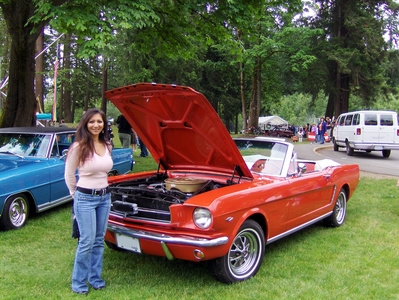
The throwout bearing in your Mustang's manual transmission reduces friction between the clutch actuating lever and the fingers on the clutch's pressure plate. This allows the actuating lever to be stationary while the pressure plate rotates. Occasionally the throwout bearing will fail. If you hear a groaning or whining sound as you're driving that goes away when you put pressure on the clutch pedal, chances are your throwout bearing is going bad. You can replace the throwout bearing in about two to three hours.
Park the car and firmly set the parking brake. Place the jack under the center of the front frame cross member and lift the car until the wheels are well clear of the ground. Place two jack stands on either side of the jack at the same height and lower the car onto the stands. Lower the jack and move it to the rear of the vehicle under the differential. Lift the car to the same height. Place the jack stands under the axle housings on either side of the jack at the same height and lower the car onto the stands.
Disconnect and remove the exhaust between the exhaust manifold(s) and the axle. The exact process for this will differ depending on what engine you have and if you have single exhaust or performance dual exhaust. At the manifold end, rotate the 3 or 4 bolts that secure the exhaust pipe flange to the manifold counterclockwise with a ratchet and socket. At the rear rotate the bolts on the pipe clamps counterclockwise to loosen them. Twist the pipe connections back and forth to remove them. Breaking the exhaust into smaller pieces (where possible) will make this easier.
Disconnect the driveshaft from the differential. Again, depending on which version of the Mustang you have, this will either entail rotating four bolts on the differential flange counterclockwise or removing two U-clamps securing the U-joint to the differential. Slide the differential straight back to remove it and carefully set it aside.
Disconnect the shifter linkage. You may either need to remove locking pins, U-clips , C-clips or bolts to do this, again, depending on year and exact model. Use a rubber band or wire tie to secure the linkage away from the transmission. Find the speedometer cable or speed sensor and disconnect it. Some models will require you to remove a bolt by turning it counterclockwise, while others will have an electrical connector. Disconnect the reverse light harness by depressing the locking tab and pulling it straight out from the transmission. Use a wire tie or rubber band to secure these away from the transmission.
Disconnect the clutch actuating cable from the actuating lever. It may be bolted, clipped or held in place by tension. Secure the cable away from the transmission.
Remove the bolts securing the transmission to the engine block. There will be either four or five bolts on both sides, depending on engine and transmission size.
Slide the jack under the engine from the front and place the block of wood on the jack pad. Lift the jack until it makes contact with the oil pan.
Rotate the two bolts on the transmission mount counterclockwise with the ratchet and socket to remove them. Remove the two cross member to frame bolts (one on either side) by holding the bolt head with a wrench while turning the nut counterclockwise with the ratchet and socket. Remove the bolts and set the cross member aside.
Grasp the transmission bell housing in one hand and the output shaft with the other and carefully lift the tail while sliding the transmission towards the rear of the engine. Carefully set the transmission on the ground. Use extreme care as the transmission is heavy.
Push the clutch actuating lever towards the rear of the transmission and slide the throwout bearing off the end of the lever. Slide the new throwout bearing onto the actuating lever in the reverse direction.